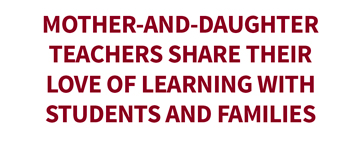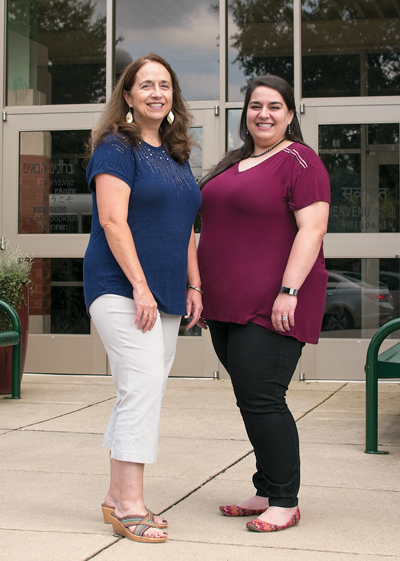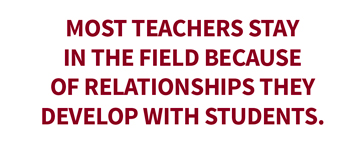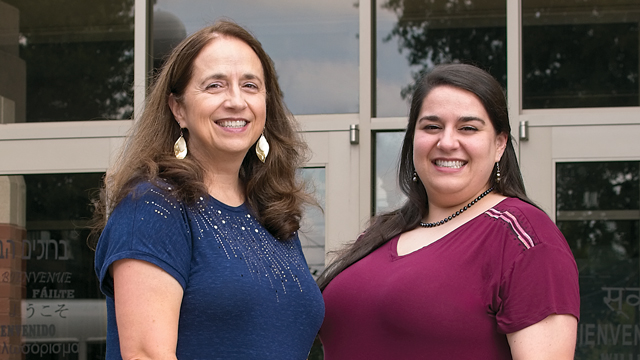Lynn Reed and her daughter Hana Reed Voight share more than just a family tie. They share a passion for learning. That’s why each ultimately chose teaching as a career. Keeping it in the family, they both teach at Maggie L. Walker Governor’s School – Lynn in math (calculus and pre-calculus) and Hana in history (AP European history, AP human geography, and global studies). Lynn joined the staff of Maggie Walker in 1998, and Hana came on board in 2011.
Lynn got into the profession because of her love of math and her desire to interact with people. She gets great joy in taking a subject that often intimidates people like math and helping them “understand a difficult concept or skill that had been an obstacle for them,” she says. “I like helping them realize they can do it.”
Even though her mom is a teacher and her father works in education, Hana didn’t decide to go into teaching until she was a senior in high school and took an AP European history class. “My teacher was a phenomenal storyteller who made history come alive,” Hana says, adding, “I grew up with teachers. I knew what it was like to be a teacher, and I figured it was probably a good fit.”

The two enjoy collaborating at work and helping their students discover concrete connections between math and history. “Hana does a unit on population growth that’s great for my calculus students,” Lynn says. The teachers were asked to present this interdisciplinary curriculum at state social studies and math conferences.
Over the years, Lynn has been able to bring real-world examples into her classroom. A few years back, she was awarded a fellowship that allowed her to work at the National Science Foundation for two years looking at the climate science that affects the polar regions of the world. “I was able to come back and enlighten students about ways they can use math regarding something that is very topical,” she says.
Through teaching, Lynn and Hana were able to travel to Spain and Morocco to look at history, math, and geography. “It was a study experience . . . something that was really great for us to share, not only as mom and daughter, but also as colleagues. It was a really cool multicultural, multidisciplinary experience,” Lynn says.
Putting It All Together
In the classroom, Hana uses the art of storytelling to help students connect to historical moments on a personal level. “Anything I can do to pull them in,” she says. “I love it when the kids keep asking questions about the stories.”
Her human geography class gives students the chance to see how everything from agriculture to industry connects people. “It pulls together all aspects of life,” she says. “It helps students understand the world we live in.”

For a school that focuses on government and international relations, that perspective is valuable. Maggie Walker is a public magnet school which enrolls students from twelve different districts that range from urban to rural living. Student experiences vary, and that can often lead to a teachable moment for both mother and daughter. “One year, I had a kid from Prince George from a farm, and I had a kid from the city who thought of cows as zoo animals,” Hana says. “Being able to bring together those experiences can open up the world around them.”
Drawing from different areas can present interesting challenges. Getting students “to a similar point can be difficult, but it’s also beautiful,” Hana says. “They get to meet so many kids from different places.”
Teacher community and collabo- ration are important for Hana and Lynn. “When you are in a supportive environment, you get such an extra benefit,” Lynn says. “The best part is when you can have conversations and draw out connections that were unexpected.”
Hana finds that her fellow teachers are always helpful if she has something she can’t figure out. “It’s a pleasant experience,” she says. “You have great colleagues.”
Teaching is a Lifestyle
While they love what they do, both women can understand why new teachers might become disenchanted with the job. It often involves buying into misconceptions about the amount of work involved or the sheer multitude of tasks that have to be completed on a daily basis.

“If you get into thinking all you have to do is provide good content in the classroom, you won’t last. There are so many things
beyond the classroom, such as professional development mandates from the state,” Hana says. “There is a lot more involved than just standing up and providing content.”
The mistaken notion that teachers can leave promptly at three-thirty in the afternoon every day and have a full summer off “is laughable,” adds Lynn. “In the summer, a lot of teachers will be attending workshops or institutes at their own cost. You have to go into teaching with eyes wide open. You have to get experience and decide if it’s a good fit.”
Committing to the Profession
In her early years of teaching, Mavis Brown, associate professor of education at University of Richmond, saw more students committed to teaching than she sees now. “Out of my class of sixteen (first- and second-year) students, I had all but three go halfway through saying they were interested, but not sure they would go through the teacher licensure program,” she says, noting the number of students who declare education as a major has been decreasing across the nation.
This spring, there were 1,000 teaching vacancies across Virginia, according to research by the career services department at University of Richmond. “These classes don’t have licensed teachers in the classrooms, they have provisional teachers,” Brown says.
The Metlife Survey of American Teachers found that teacher job satisfaction has dropped fifteen points since 2009, from 59 percent who were very satisfied to 44 percent, the lowest level in more than twenty years.
In addition, the percentage of teachers in the nation who say they are very or fairly likely to leave the profession has increased by twelve points since 2009, from 17 percent to 29 percent.

Brown finds the low number of students going into education disconcerting. “In my observation, young people who are eighteen or nineteen are a little more reluctant to commit to teaching than they may have been in the past,” she says.
What she does find encouraging is the growing number of people who have worked in other professions who are enrolling in the university’s career switcher program. “People do this for all different reasons,” Brown says. “It’s a good sign because we need credentialed teachers in classrooms.”
In polling her students, Brown finds they have varied reasons as to why they want to get into teaching. “What I hear most often is, ‘I want to make a difference,’ and that is an admirable trait,” she says. “Some have had teachers who have impacted their life. Some are inclined to have empathy for children who are in difficult situations, and they want to be of help to them.”
Helping others is one of the biggest rewards of teaching, Brown adds. “I believe most teachers stay in the field because of the relationships they develop with students and the growth they see and know they were a part of. Often those outweigh the negatives.”
All of the rewarding moments that teachers experience compensate for the long hours and hard work. “They are pretty amazing,” Hana says of those moments.
The work environment also factors into a teacher’s satisfaction level. “We have quite a few teachers who were here at Maggie Walker when I joined and are still here,” Lynn says, adding that teachers who make it through the critical first five to seven years feel connected to the school and to the community.
Lynn and Hana believe one of the best ways to discover the pros and cons of teaching is to talk to several teachers and get an idea of what it’s like to be a teacher today.
“It’s more than a job in many ways. It’s a lifestyle,” Hana says. “I don’t think everyone has a perspective of what it’s like. I am lucky because I saw my mom teach for many years. I had a good perspective.”




